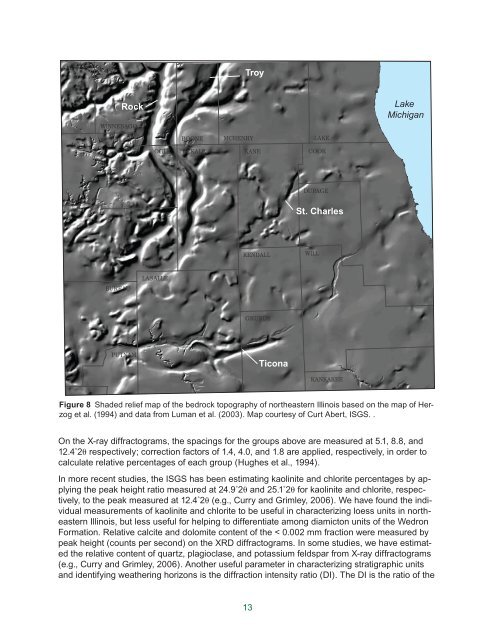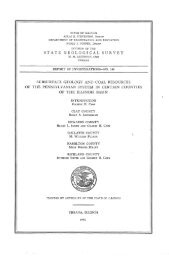Deglacial History and Paleoenvironments of Northeastern Illinois
Deglacial History and Paleoenvironments of Northeastern Illinois
Deglacial History and Paleoenvironments of Northeastern Illinois
- No tags were found...
You also want an ePaper? Increase the reach of your titles
YUMPU automatically turns print PDFs into web optimized ePapers that Google loves.
TroyRockWINNEBAGOBOONE MCHENRY LAKELakeMichiganOGLEDEKALBKANECOOKDUPAGELEESt. CharlesKENDALLWILLBUREAULASALLEGRUNDYPUTNAMTiconaKANKAKEEFigure 8 Shaded relief map <strong>of</strong> the bedrock topography <strong>of</strong> northeastern <strong>Illinois</strong> based on the map <strong>of</strong> Herzoget al. (1994) <strong>and</strong> data from Luman et al. (2003). Map courtesy <strong>of</strong> Curt Abert, ISGS. .On the X-ray diffractograms, the spacings for the groups above are measured at 5.1, 8.8, <strong>and</strong>12.4˚2 respectively; correction factors <strong>of</strong> 1.4, 4.0, <strong>and</strong> 1.8 are applied, respectively, in order tocalculate relative percentages <strong>of</strong> each group (Hughes et al., 1994).In more recent studies, the ISGS has been estimating kaolinite <strong>and</strong> chlorite percentages by applyingthe peak height ratio measured at 24.9˚2 <strong>and</strong> 25.1˚2 for kaolinite <strong>and</strong> chlorite, respectively,to the peak measured at 12.4˚2 (e.g., Curry <strong>and</strong> Grimley, 2006). We have found the individualmeasurements <strong>of</strong> kaolinite <strong>and</strong> chlorite to be useful in characterizing loess units in northeastern<strong>Illinois</strong>, but less useful for helping to differentiate among diamicton units <strong>of</strong> the WedronFormation. Relative calcite <strong>and</strong> dolomite content <strong>of</strong> the < 0.002 mm fraction were measured bypeak height (counts per second) on the XRD diffractograms. In some studies, we have estimatedthe relative content <strong>of</strong> quartz, plagioclase, <strong>and</strong> potassium feldspar from X-ray diffractograms(e.g., Curry <strong>and</strong> Grimley, 2006). Another useful parameter in characterizing stratigraphic units<strong>and</strong> identifying weathering horizons is the diffraction intensity ratio (DI). The DI is the ratio <strong>of</strong> the13
















